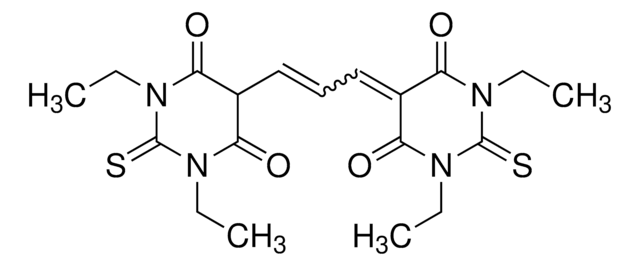D8064
4-(2-(6-(Dibutylamino)-2-naphthalenyl)ethenyl)-1-(3-sulfopropyl)pyridiniumhydroxid Inneres Salz
≥95% purity (HPLC), solid
Synonym(e):
Di-4-ANEPPS
About This Item
Empfohlene Produkte
product name
4-(2-(6-(Dibutylamino)-2-naphthalenyl)ethenyl)-1-(3-sulfopropyl)pyridiniumhydroxid Inneres Salz, ≥95% (HPLC), solid
Qualitätsniveau
Assay
≥95% (HPLC)
Form
solid
Mol-Gew.
480.66
Farbe
orange to dark red
Löslichkeit
DMF: soluble
DMSO: soluble
ethanol: soluble
ε (Extinktionskoeffizient)
≥38000 at 493-499 nm in methanol
Anwendung(en)
diagnostic assay manufacturing
hematology
histology
Lagertemp.
2-8°C
SMILES String
CCCCN(CCCC)c1ccc2cc(\C=C\c3cc[n+](CCCS([O-])(=O)=O)cc3)ccc2c1
InChI
1S/C28H36N2O3S/c1-3-5-17-30(18-6-4-2)28-13-12-26-22-25(10-11-27(26)23-28)9-8-24-14-19-29(20-15-24)16-7-21-34(31,32)33/h8-15,19-20,22-23H,3-7,16-18,21H2,1-2H3
InChIKey
HAPJROQJVSPKCJ-UHFFFAOYSA-N
Anwendung
Biochem./physiol. Wirkung
Lagerklassenschlüssel
11 - Combustible Solids
WGK
WGK 3
Flammpunkt (°F)
Not applicable
Flammpunkt (°C)
Not applicable
Persönliche Schutzausrüstung
Eyeshields, Gloves, type N95 (US)
Choose from one of the most recent versions:
Besitzen Sie dieses Produkt bereits?
In der Dokumentenbibliothek finden Sie die Dokumentation zu den Produkten, die Sie kürzlich erworben haben.
Kunden haben sich ebenfalls angesehen
Unser Team von Wissenschaftlern verfügt über Erfahrung in allen Forschungsbereichen einschließlich Life Science, Materialwissenschaften, chemischer Synthese, Chromatographie, Analytik und vielen mehr..
Setzen Sie sich mit dem technischen Dienst in Verbindung.
![4-(2-[6-(Dioctylamino)-2-naphthalenyl]ethenyl)-1-(3-sulfopropyl)pyridinium Inneres Salz ≥95% (HPLC), solid](/deepweb/assets/sigmaaldrich/product/structures/276/606/9b895cb0-f3b8-42d2-bceb-a788c0bcf884/640/9b895cb0-f3b8-42d2-bceb-a788c0bcf884.png)








